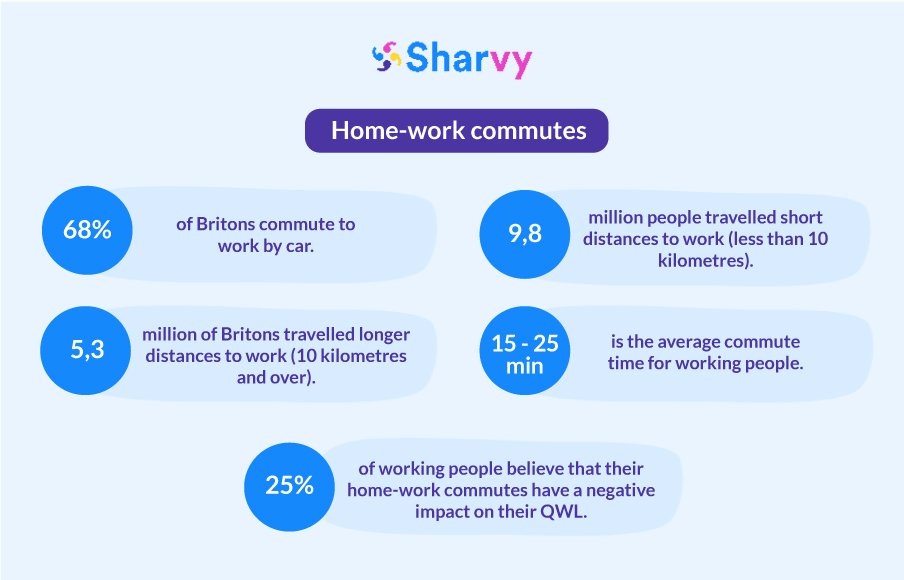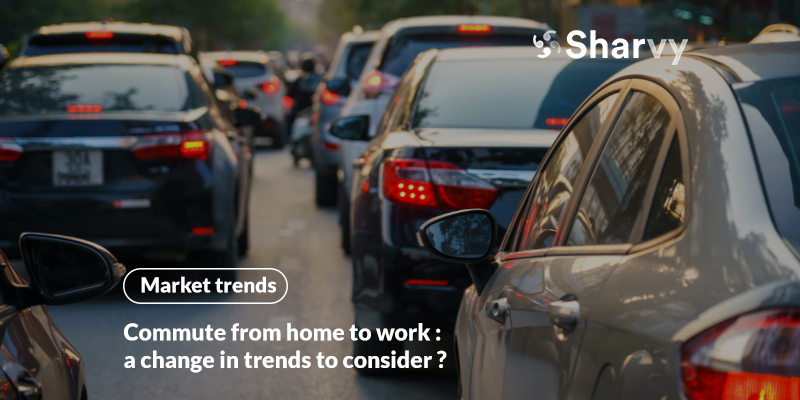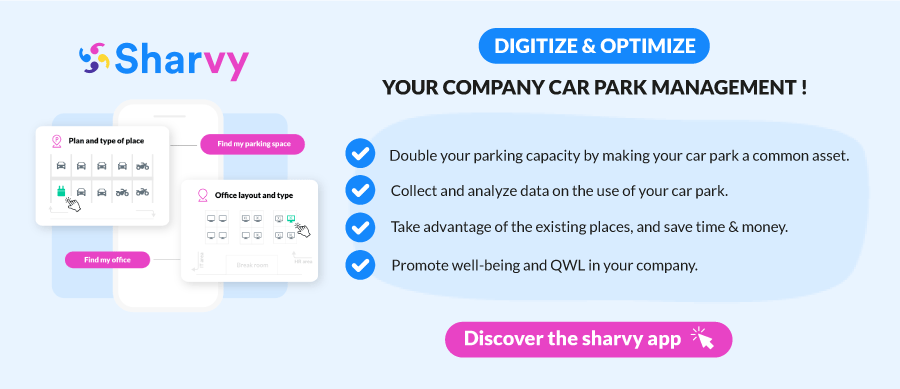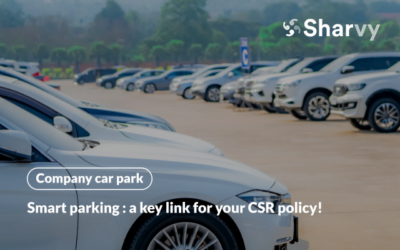Every morning, millions of people embark on a journey that is familiar to us all : the commute from home to work.
From the hustle and bustle of public transport to the (often) congested arterial roads, each journey is a chapter in the story of our daily lives.
For some people, it’s a chance to reflect, but for others, it’s a frantic race against the clock. Between anticipating the day ahead and reflecting on the one that’s coming to an end, these moments between home and the office are much more than a simple commute.
They shape our days as much as they influence our professional and personal lives.
However, behind the apparent triviality of these journeys lies a complex subject involving societal, economic, and environmental issues. In this article, we delve into the heart of this evolution, exploring the challenges, risks, and opportunities it brings to the contemporary world of work.
Commute from home to work : 5 figures you need to know to shape the future.

In recent years, several studies have looked at the issue of commuting :
- 68% of Britons commute to work by car (Study : “Transport Statistics Great Britain”). While the car reigns for long commutes, it remains predominant for short distances (less than 5km). Even more alarming, it is at the time when it is most penalizing, namely, during rush hour, that the cars carry only one person.
- 9,8 million people travelled short distances to work (less than 10 kilometres) (Census Study). Obviously, these trends differ depending on the region, the size of the conurbation and the areas (urban & rural) in which these journeys are made. Over the years, we have unfortunately seen a (significant) increase in commuting distances.
- 5,3 million of Britons travelled longer distances to work (10 kilometres and over) (Census Study). In this case too, the British prefer the car to other means of transport (train, carpooling, cycling, etc).
- 15 to 25 minutes is the average commute time for working people (Study : “Duration of daily commute”). As distances increase, so do journey times. Unfortunately, longer distances mean greater dependence on the private car.
- 25% of working people believe that their home-work commutes have a negative impact on their QWL (Quality of Life at Work). 72% of them also say that they are a waste of time (Study : “Work at home and the Quality of Working Life”).
These figures raise several challenges that companies need to consider more than ever. However, faced with this complexity, there is no universal solution. Individual situations are diverse and complex and require a multidisciplinary approach. However, public authorities and companies are crucial in encouraging and supporting these changes. We look at this in the following paragraphs.
Commute from home to work : a complex subject, concealing real risks ?
There’s no doubt about it : as we saw above, commuting is a complex issue, giving rise to several risks for companies and their employees.
From the point of view of companies, managing these commutes is an arduous task, often relegated to second place. Despite the existence of preventive measures, their implementation remains marginal due to a need for recognition of the importance of this subject. Even today, employers perceive commuting to and from work outside their remit. Instead, they see it as :
- A regional planning issue (e.g : inadequate infrastructure, etc).
- Fixed data linked to the company’s operations (location, working hours, etc).
- Data resulting from employees’ choices : place of residence, mode of transport.
But employers who think like that are wrong! Commuting is now at the crossroads of three crucial areas for companies: Human Resources (HR), Corporate Social Responsibility (CSR), and public policy.
For employees, commuting is synonymous with stress and fatigue once the commute time exceeds 30 minutes. It becomes a source of tension and exhaustion. What’s more, these commutes can add to the pressures of work, resulting in a build-up of stress that (obviously) doesn’t bode well for the start of the working day.
Moreover, the private car still dominates the home-work commute, and it’s clear that it generates stress (frequent traffic jams, road congestion, unforeseen delays). This is even though car-sharing and public transport are seen as economically and environmentally advantageous alternatives. However, the lack of autonomy associated with these modes of transport is a significant barrier to their adoption.
What can be done ? 5 ideas for companies to consider.
1. Incorporate the issue of commuting into your HR policy.
Did you know ? The longer it takes to commute to work, the higher the rate of absenteeism and the lower the motivation of employees. That’s why companies are now seeking to define an ambitious Mobility Plan. It’s now a key HR issue!
So, how do you go about it ?
Firstly, Human Resources (HR) departments must conduct an in-depth analysis of employees’ needs and preferences regarding commuting & company car park management. This can be done through surveys, polls, and focus groups to understand preferred modes of travel, constraints, and expectations.
For example, if the survey results reveal that most of your employees prefer to use public transport, but need help with the frequency of timetables. In response, your company can consider solutions such as flexible working hours and contributing to the cost of public transport season tickets.
In response to the challenges posed by home-to-work commutes, your company should consider intensifying its support for public transport and alternative transportation means. Encouraging the use of trams, collective transportation, and car-sharing can not only improve the quality of work life (QWL) but also reduce pollutants emitted during business trips. The adoption of such practices also promotes a more active and less stressful lifestyle for employees.
At the same time, don’t forget that your company’s HR policy can also encourage teleworking and the adoption of flexible working hours to enable your employees to reduce their commuting time and avoid rush hours. This can help to reduce the stress of commuting, improve work-life balance and increase job satisfaction.
As a result, although commuting is not considered as actual working time, there are a number of measures that can be put in place by the HR department, and are even encouraged by laws and regulations in the United Kingdom.
2. Encourage and facilitate alternatives to the private car.
We’re not telling you anything new if we point out that today, several million professionals work in sedentary jobs, with increased use of screens.
As the years go by, we insidiously lose our physical capacities and (unfortunately) move around much less. For example, the car is replacing the bicycle. The bicycle becomes electric. Televisions are remote-controlled. The shutters are electric. Gates can be opened remotely. Shopping is increasingly done at the drive… The list goes on!
While we gain comfort, paradoxically, we lose some of our “health capital”. Some of the most prominent and familiar adverse effects include backache, neck and shoulder pain due to poor posture, muscle tension,, and contractures.
But these are not the only effects. A more sedentary lifestyle increases the risk of certain diseases. These include obesity, type 2 diabetes, certain types of cancer, cardiovascular disease, etc.
As you can see, companies need (more than ever) to prevent these risks to ensure the long-term well-being of their employees. To do this, you can encourage (and above all, facilitate) alternatives to the private car.
For example, encourage cycling to and from work, for example, by installing a bike rack in your company car park. Similarly, encourage running and walking by installing changing rooms and showers in your workplace.
For employees who are open to these modes of transport, the home-work commute is often an opportunity to let off steam and relieve accumulated nervous tension. If the company does not set up the necessary infrastructure, employees are unable to fit in their daily exercise (because of very busy days). Commuting to and from work is therefore a time that has become essential to their balance, and one that needs to be taken into account.
At the same time, make car-sharing easy! Many people enjoy this practice, not only because it relieves the day’s fatigue by sharing the road with other passengers. But also because, thanks to carpooling, journeys are less restrictive and more pleasant : everyone gets to know each other better, and this is all the more true if the employees are not part of the same team and don’t see each other much in the company.
3. Seize the opportunities offered by a Parking Management application.
At first glance, you might think that focusing on your car park’ parking policys would encourage your employees to take the car, but in fact the opposite is true.
Good car park management ultimately opens the door to the development of sustainable mobility. For example, in the Sharvy application, priority access rules to the car park have been established for employees who carpool.
These preferential rules encourage employees to change their behavior over the long term. At the same time, you reduce the number of parking spaces required and improve the management of your company car park.
In the same way, with a parking management application like Sharvy, you can encourage rotation in the use of parking spaces.
You are encouraging car park holders to be less reluctant to use public transport, just as you are encouraging them to favor soft mobility on one day of the week. And all without losing the use of their parking space, which fosters multimodality.
At the same time, you relieve your employees of the daily stress of parking problems. Before they arrive on-site, they can use the application to get an overview of what’s available in your car park over the next few days so they can plan their mobility (for example, if the car park is complete, they’ll give preference to a two-wheeler wherever possible).
4. Draw up an Employer Mobility Plan (EMP).
The Employer Mobility Plan (EMP) is an initiative developed and agreed upon within organizations, designed to orchestrate your employees’ home-work journeys methodically and considered.
Being attentive to individual needs creates an environment conducive to the well-being of your employees & in line with contemporary expectations in terms of QWL.
It includes a program of actions specific to the company’s situation, a financing plan, a timetable for carrying out the actions, and monitoring and updating procedures.
Remember to include your employees in the design process when building your EMP. This fosters a feeling of belonging and of being valued, for example, by setting up participative workshops to enable them to contribute to the plan’s development. Doing this strengthens collaboration and mutual trust, two essential elements in retaining your employees.
5. Organize awareness-raising campaigns about the challenges of commuting.
To do this, start by clarifying the aims of your campaign, whether it’s to reduce carbon emissions, promote car-sharing, or encourage alternative modes of transport to private cars.
At the same time, identify your employees most prone to commuting issues and tailor your messages accordingly. Establish clear & persuasive messages (in this case, messages that open your employees’ eyes to the individual and collective benefits) of adopting sustainable travel behavior.
Use various communication channels, such as emails, posters, intranets, social networks, presentations at team meetings, etc.
But above all, provide (practical & activatable) resources. Such as maps of cycle routes, information on public transport, and route planning tools. In addition, and wherever possible, offer incentives such as competitions (challenges) to encourage participation.
Finally, evaluate & adjust your campaign. To do this, collect a range of data (for example, the car-pooling participation rate, the increase in the use of public transport, the car-park sharing rate, etc.) and adjust your strategies accordingly to improve your results!
In conclusion
While commuting issues may still seem marginal for some companies, awareness is growing, and action has been taken in recent years. This is due to the significant impact of these journeys on companies’ energy balance sheets and their direct impact on employees’ daily lives and well-being.
This is why companies now have no choice but to take action on their employees’ mobility practices, not only to retain and attract new talent but also because it is an essential lever for supporting their CSR policy and reinforcing their image as a responsible employer.
Have a question ? Check out the FAQ !
How can company parking policies influence employees' transport choices?
There’s no doubt about it: as a company, you directly impact your employees’ mobility. You can influence your employees’ transport choices with a well-thought-out and fair parking policy.
On the one hand, your company can use the allocation of parking spaces to promote sustainable modes of transport by reserving unique spaces for bicycles, electric scooters, and electric vehicles.
On the other hand, your company can introduce differentiated parking policies according to the needs of your employees, for example, by offering parking benefits (such as a dedicated parking space) to employees whose home is a certain distance from the workplace and who have no other practical public transport alternatives (carpooling, train, etc.).
At the same time, thanks to a parking management application like Sharvy, you can encourage rotation in parking spaces, making car park holders less reluctant to favor soft mobility. And all without losing the use of your parking space.
What is the impact of commuting on diversity and inclusion in the workplace?
First, it should be remembered that commuting provides the brain with a necessary transition between the personal and professional spheres. In their absence, this separation can be compromised, giving way to a constant preoccupation with work, leading to anxiety, concentration difficulties, sleep disturbances, and even an increased risk of burn-out.
However, while they are indispensable in everyday life, they can also hinder diversity and inclusion in the workplace, particularly for those who spend long hours traveling. This can influence diversity by discouraging specific candidates, such as single parents or people with disabilities, from applying for jobs requiring long and tiring journeys.
At the same time, workers from different socio-economic backgrounds may have different abilities to travel to work, depending on the availability of public transport, the proximity of transport infrastructure, and the possibility of owning a car. This can also influence the diversity of your workforce and access to career opportunities.
Why should companies encourage the use of alternative transport options for commuting?
Encouraging the use of alternative transport options for commuting helps support sustainable mobility while reducing employees’ transport costs. Urban transport options, such as bike-sharing services or personal vehicles with electric assistance, offer practical and eco-friendly alternatives to motorists. This helps to limit road trips, reduce mileage, and contribute to fighting pollution in urban areas.
The Mobility Orientation Law also encourages the adoption of these new modes of transport, particularly by providing allowances to cover actual travel expenses related to professional commuting. Furthermore, solutions like bike rentals or public transportation can be integrated into company travel practices, thus reducing costs for both employees and employers.
For commuting, especially in urban areas or for part-time employees, these alternatives are an effective way to facilitate daily trips while contributing to better management of travel expenses. By offering eco-friendly transport solutions, companies actively participate in reducing their carbon footprint and support future mobility trends.
Want to learn more? Check out our latest articles!
Company relocation : an opportunity to give a fresh start!
Are you about to carry out a company relocation? In this article, find out our top tips for getting the most out of your move.
Future of work : what trends and technologies lie behind this notion?
Between utopia and dystopia, what can managers expect and how can they prepare for the “Future of work” ? The answers here!
Smart parking : a key link for your CSR policy!
What are the benefits of smart parking for your CSR policy? How do you set it up? What solutions can you turn to? Find the answers here!
Subscribe to our newsletter!
Resources
Contact us
+44 117 463 6990





